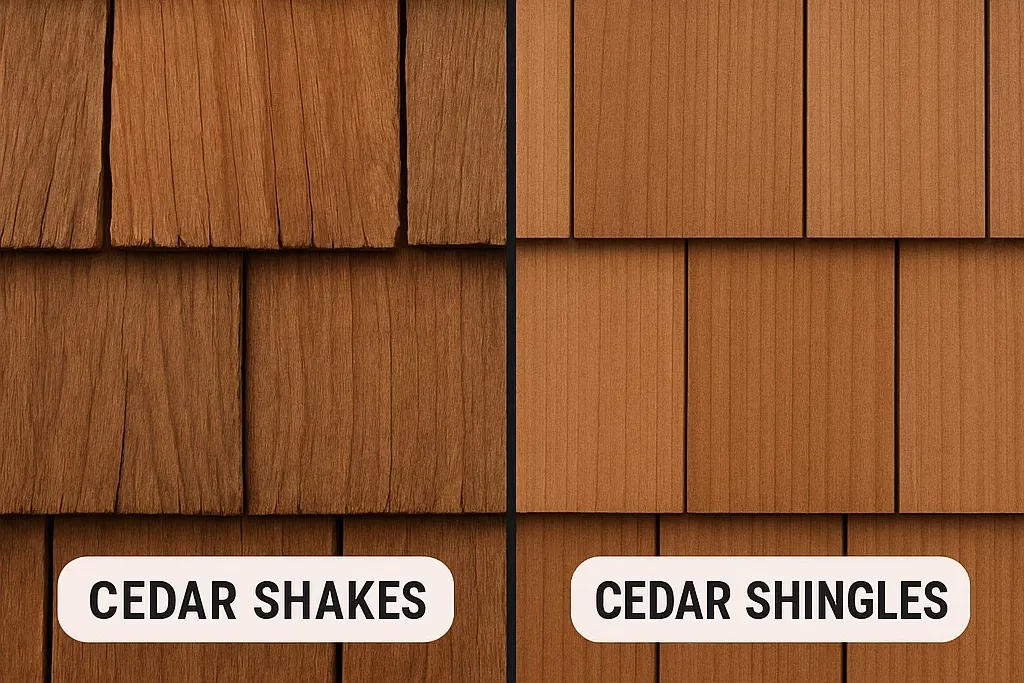Have you ever wondered what is the difference between cedar shakes and cedar shingles? Or maybe you thought that it’s exactly the same? While most of the American homeowners care only if their roof is covered with natural cedar or not, the way how the wood is cut is absolutely crucial. This the reason why we decided to explain you whether you should shingles or shakes when planning a roof replacement.
Table of Contents
What Are The Key Differences Between Cedar Shakes And Shingles?
While cedar roofs look generally the same, it’s worth noting that when giving a closer look, you will probably easily recognize the differences between shake and shingle roofs. These are:
Cedar Shingles Are Smooth, Shakes Have Uneven Surface
One of the biggest differences between shingles and shakes is the way they are produced. As a rule, cedar shingles are sawn on both sides by machines. Because of that, their surface is flat and even. At the opposite, shakes are traditionally hand-split, what results with more rugged surface and rustic appearance.
Cedar Shakes Are Generally Thicker
Since shakes are hand-sawn (or split), they are noticeably (up to twice as much) thicker. Usually, their thickness ranges somewhere between 1/2″ and 3/4″, while shakes measure between 0.3″ and 0.5″.
While the shingle or shake longevity derives mainly from the kind of a wood quality, the dimensions are also important. In normal conditions and if properly installed, shakes should last slightly longer – up to 30-35 instead of 20-25 years.
Shingle Roof Surface is Harmonized And Smooth, Shake Roof Does Not
Just as asphalt shingles, cedar shingles are also rectangular, and their edges are straight. Therefore, they can be easily installed evenly, and the entire roof has elegant, uniform look. Since cedar shakes are split by hand, their dimensions differ, and the roof surface is much more diverse – therefore you can achieve “rustic charm”.
To achieve a watertight roof with wood shingles, you simply need to lay the 3 layers. To achieve the same with hand split shakes, roofer need to spend much more time, sorting pieces of cedar and placing them in a strict order. It obviously affects the labor cost, making shake roofs more expensive.
Difference Between Wood Shingles And Shakes in Terms of Grain Structure

When it comes to new roof installation, you should also decide what kind of grain you choose. You can opt for edge-grain, flat-grain and slash grain shingles (or shakes).
In the vast majority of cases, shakes as well as shingles may be cut in order to achieve either grain structure. In practice, homeowners decide on edge-grain shingles more frequently, but it’s mainly because that these people are usually ready to pay more, if the quality is better. While edge grain shakes (or shingles) are renowned for their increased durability and curling resistance, customers with more limited budget can opt for flat grain shakes, which are usually cheaper. Unfortunately, it translates into inferior properties of such a roof.
Are Wood Shakes Better Than Shingles?

Roofers usually use term “cedar shakes”, not “cedar shingles”, but we believe that it derives from will of distinction cedar shingles from asphalt shingles. In fact, new cedar shake roofs are hardly ever seen nowadays, as customers prefer wood shingles as a roofing material – just because of their aesthetics.
Whether you choose shakes or shingles, much more important criteria is the kind of cedar wood, it’s thickness and grain structure. These factors influence the roof’s real performance and longevity. As long as the only difference between wood shingles and wood shakes is their aesthetic appeal, it doesn’t matter in our opinion.
What Kind of Cedar Shakes or Shingles Should I Get?

If you live in rather inhospitable climate (Canada, Alaska, Maine, New Hampshire), you should definitely go for thick (3/4″ or even 1″), hand-split or resawn shakes. As they are thicker than shingles, their supposed lifetime is longer – the thicker the pieces of wood are, the better. If you opt for alaskan yellow cedar , which is generally much more robust than western red cedar, you should count on 30-40 years without thinking about a new roof or significant repairs.

The difference between wood shingles and shakes is less remarkable if your home is located in a rather mild climate. Homeowners from Kansas, Missouri, Virginia or Idaho can choose cedar wood shakes what they want, without prioritizing their thickness. In our opinion, mid-range, 1/2″ thick shingles made of western red cedar or eastern white cedar will work perfectly.
It’s worth adding that wood roof is not a great choice if you live in humid areas, such as Florida, Louisiana, Missisipi or Georgia. High temperature and water vapor in the air lead to growth of mold and premature aging. In such a climate, natural wood as a roof cover is simply bad choice. However, if you are in desperate need of natural look of cedar, you should aim for slash-grain or edge-grain shingles – these should give you the highest level of curling and humidity resistance. Nevertheless, it’s still much better to install steel or aluminum roof.


Leave a Reply